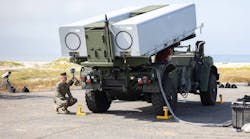ARLINGTON, Va. – U.S. military researchers will brief industry in June on several upcoming microelectronics technologies projects concerning photonic, quantum, and organic circuits; sustainable microsystem manufacturing; and commercial scaling with military-only capabilities.
Officials of the U.S. Defense Advanced Research Projects Agency (DARPA) Microsystems Technology Office (MTO) in Arlington, Va., will brief industry from 9 a.m. to 4:30 p.m. eastern time on 24 June 2024 in-person and online during a DARPA MTO open house.
DARPA researchers will detail upcoming efforts photonic, quantum, and organic circuits; sustainable microsystem manufacturing; and commercial scaling with military-only capabilities. Briefings will correspond with the release in June of an unclassified MTO office-wide broad agency announcement (BAA).
Briefings will feature presentations by and private meetings with DARPA MTO program managers. The briefings will be at the DARPA Conference Center at 675 N Randolph St., Arlington, Va., and streamed virtually via ZoomGov from 9:00 a.m. to 2:45 p.m. eastern time.
Upcoming MTO work will focus on three major thrusts: photonic circuits; quantum circuits; and bio/organic circuits.
Photonic circuits focus on using light at the chip-scale; quantum circuits focuses on the discovery of new hardware metrics invent scalable devices; and bio/organic circuits focuses on integrating biomolecules and micro-technologies for future molecular integrated circuits.
Upcoming MTO work also will focus on developing the infrastructure to support sustainability in advanced microsystems, such as additive, subtractive, and hybrid fabrication tools; environmentally sustainable manufacturing; ways to speed up time to market; and ecosystem enhancements. Work also will concern dual use by design to take advantage of commercial scaling, and to find ways to build superior capability into defense microsystems.
Upon registering, each attendee must upload a two-page executive summary of capabilities, points of contact, facility clearance level, relevant interest areas, and experience.
Briefings will cover:
-- understanding how to quantify the utility of quantum computing;
-- resilient supply chains and trustworthy systems;
-- using optics with microsystems; integrated quantum photonics and nonlinear optics for sensing; ultra-low-noise microsystems using chip-scale optics for sensing and communications; microsystems that create strong light-matter interactions; multiphysical microsystems for couplings between optics, acoustics, and RF systems; and photonic-electronic integration and co-design;
-- cognitive RF systems and advanced processors such as using large-scale real-time RF emulation for autonomous RF systems; scalable biological, chemical, or other non-semiconductor processors; and receiver processors that can reprogram themselves;
-- microsystems in quantum sensing; positioning, navigation, and timing (PNT); and communications;
-- superconductor electronics for computing and sensing systems, such as full-spectrum staring with unprecedented sensitivities, ultra-high-rate analog-to-digital conversion; high-speed signal processing and beam forming; near-zero dissipation computing; and cryptanalytic neuromorphic computing.
-- high-performance and energy-efficient ultra-compact microsystems for use in adverse environmental conditions, such as materials with adaptive thermophysical properties; sustainable approaches for energy management; and ways to operate under extreme thermal environments;
-- combining high-performance computing (HPC), vulnerability assessment, media forensics, and life cycle analyses of embedded computing systems for cyber security;
-- technical challenges in sensor systems, microsystem manufacturing, and cyber-physical systems;
-- advanced low-volume semiconductor circuit manufacturing and scale integrated photonic system performance;
-- processing image information using the imaging signal chain that have not been well explored, such as metasurface optics, optical processing of image data early in the signal chain, and advanced imaging readout integrated circuits; and
Related: Next step for semiconductors: nanometer integration
-- overcoming technical challenges in hardware and software co-design, co-synthesis, and co-security.
Register for these briefings no later than 31 May 2024 online at https://web.cvent.com/event/5e4baecc-89b0-482e-a2f6-e14f56a47f31/websitePage:2fc2ad49-a6c5-49fd-ad2e-c256ec101e52.
Email questions or concerns to [email protected]. More information is online at https://sam.gov/opp/9d378e8877334e249e62c7e4988307c2/view.



